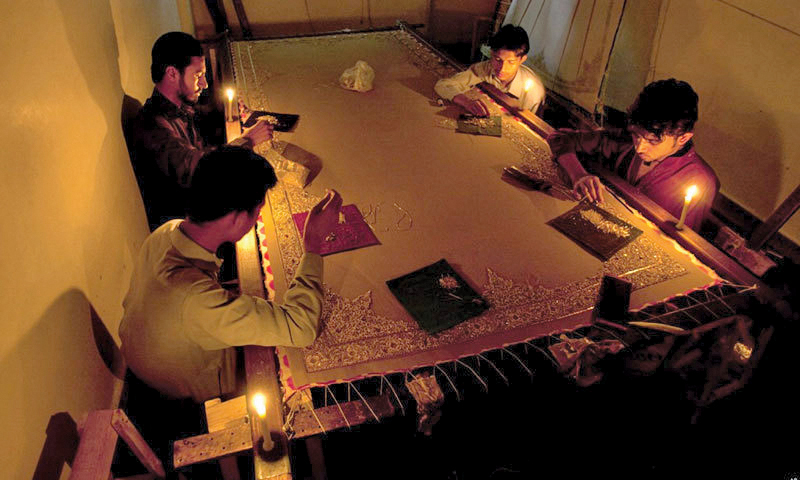
In all the advice and proposals that are normally given, transparency of the type that is required is generally not included. We will take up the issue of load-shedding first and discuss transparency later.
Nawaz feels the heat of power outages
An obvious answer is that supply is less than the demand. But what is supply and what is demand? There is something called installed capacity and there is another called de-rated capacity because plants get old and lose their original capacity to produce for a variety of reasons.
Then there is actually utilised capacity. Actual (de-rated capacity) may not always be utilised properly. Due to poor maintenance and planning, even re-rated capacity may not be utilised properly.
Surprisingly, there may be other reasons not to produce what one can produce. For example, it is alleged and perhaps correctly that K-Electric (and even the Ministry of Water and Power) does not run its furnace oil-based plants for financial reasons. Nepra has fined them, but to no avail.
K-Electric has de-rated capacity of 2,093 megawatts and with purchase from local IPPs (350MW) and exports from Pepco system (650MW), the total supply capability adds up to 3,093MW.
People say there should be no load-shedding. K-Electric says there is no load-shedding in the paying regions where theft and receivables are under control. The fact is that there is load-shedding.
K-Electric has a peculiar tariff system. It has been given a constant price tariff with adjustments for inflation. In this system, it is in its benefit not to run inefficient plants or the ones where fuel cost is more than what is provided in the constant price.
Also furnace oil is purchased on cash and gas perhaps can be bought on credit or adjusted with receivables.
However, one wonders that with oil prices 50% lower, is furnace oil issue still valid and instrumental in explaining the case. For a precise answer, one has to really audit the accounting data and do some scenario analysis.
I am not sure if Nepra has ever appointed some clever and professional auditors and consultants to find out the truth.
However, even if K-Electric may be browbeaten into utilising its furnace oil capacity, how about the Ministry of Water and Power. It is being accused of the same sin albeit perhaps for slightly different reason.
The government says the real dependable capacity is around 18,000MW, which it produces in summers. In winters, hydroelectric power is limited to 1,000MW instead of 6,000MW that is generated in summers and thus 11,000MW is generated during winters.
Load-shedding in summers is 8,000MW and in winters it is 5,000MW. Demand, however, has been increasing by about 1,000MW per year over the last few years, making the demand-supply balance or lack of it even worse.
Protests continue against power breakdowns, overbillings
Only 1,000MW has been added since 2013. Sometimes early heat makes the balance even worse as is the case these days in mid-April. The problem with electricity is that it comes or goes in lumps. It cannot be done yearly. It takes about three to five years to install a power plant of 1,000MW.
About 10 or more power plants with a total of 10,000MW capacity are at various but advanced stage of development and this capacity can only come online when plants are completed and commissioned in all respects.
One part less and the power plant would not be on. In some cases, part of the plants can be commissioned in advance as has been done in Bhikki where gas turbines have been installed and commissioned while steam turbines would be commissioned with a gap of some six months. Similarly, Neelum-Jhelum hydro may begin with one or two turbines.
Even if there are some problems in this package of 10,000MW whether in generation, transmission or distribution, it can be reasonably hoped that the electricity crisis would be largely over and may be difficulties would remain that are always there in life. Cheaper electricity from LNG and coal should also help reduce the cost of generation.
Data analysis
In the table, we have provided salient and condensed data on installed and de-rated capacity, annual generation and capacity utilisation factor (CUF) of three categories namely hydro (which is almost all in public sector), Genco (which are in public sector and are thermal) and IPPs (which are mostly thermal and in private sector except for Chashma nuclear plants, which are government-run through PAEC).
The table has been compiled out of the power system statistics (2015-16) released by the NTDC. Some power plants may have been left out for a variety of reasons.
The most important column is of capacity utilisation. Average total CUF is 47.52%, which is rather low, but at such an aggregate level may not serve the diagnostic purposes.
Hydroelectric power sector has a CUF of 53.71%, which is normal for such plants. We can also understand the low CUF of 38% for Gencos, which could have been at 50% under better and more efficient management. Gencos have also suffered from the lack of fuel availability.
However, what is not fathomable is the low CUF of IPPs, which should have a high CUF of around 70-80%. Around 10,000MW of IPPs’ installed capacity should give 7,000-8,000MW.
Most IPPs are in good shape to be able to run and generate electricity at a high capacity utilisation rate. The normal mantra seems to be correct that there are financial reasons for lower electricity generation and capacity issue is exaggerated.
Load-shedding should have been much less had IPPs not been under-utilised. Thus, the general perception appears to be correct unless some revolutionary argument from the power ministry indicates or prove otherwise.
In that case then, critics probably rightly argue that the ministry is not letting all the generating capacity being utilised and more costly oil-fired plants are not utilised as much as they should. At $50 per barrel, it is highly unlikely that this would help improve finances and reduce circular debt.
Cost vs tariff
Cost of generation is higher than the allowed tariff, compelling the government to pay subsidies which it promises but does not pay regularly and totally. Resultantly, IPPs do not make fuel payments and hence the term circular debt.
When the PML-N government came to power in 2013, it did pay off the accumulated circular debt, but more was created as the basic disease of higher cost of supply compared to tariff is still there.
Perhaps this may never go, as essentially the cost differential is almost equal to the theft and receivables. If both poor and rich steal and manipulate the political system, there may not be scope for improvement until the social conditions change.
Transparency
But why should a political government near the elections not pay and worsen load-shedding. It is not understandable. To find real and deeper answers, one needs to have reliable data that is available to all and here comes the relevance of transparency.
We have National Power Control Centre (NPCC) that has all the kind of relevant data. The first thing a clever water and power secretary does is that he orders NPCC not to share data even among government organisations.
They never shared the NPCC data with the Planning Commission despite efforts on the part of the latter and shared probably only concocted figures. The data should be available on websites for all so that real reasons and culprits are identified.
In most industrialised countries, this data is publicly available, sometimes free and sometimes on paid subscription.
People would keep groping for answers and would not get close to facts and actual situation. Even the government is susceptible to deception and fraud.
When the politician discovers the inefficiencies and mis-statements, it is too late. They by the time have promoted the wrong guys and removing them late has no consequence.
The explanation of the water and power minister is also correct that due to seasonal misalignment of snow melting and hot weather, the hydroelectric power production is much lesser than the usual. The million-dollar question that needs to be answered is that what amount of load-shedding is due to mismanagement and inefficiency; what amount of load-shedding could have been avoided with better efficiency and without alleged policy of controlling circular debt and subsidies and thus producing less.
If the latter is true, I think there would be nothing more foolish than this. I don’t think, they are that foolish.
Four years on, PML-N fails to end power outages
On transparency, I would urge the prime minister and the water and power minister to order online publishing of NPCC data daily so that he is not fed with concocted figures compiled manually and credibility of government data and statements improves for the benefit of all.
The writer has been member energy of the Planning Commission until recently
Published in The Express Tribune, April 24th, 2017.
Like Business on Facebook, follow @TribuneBiz on Twitter to stay informed and join in the conversation.

1730360426-0/Menendez-Brothers-(2)1730360426-0-165x106.webp)
1732534556-0/taylor-(14)1732534556-0-165x106.webp)
1725872216-0/Tribune-Pic-(3)1725872216-0-165x106.webp)
1732532771-0/BeFunky-collage-(89)1732532771-0-165x106.webp)



1732486769-0/image-(8)1732486769-0-270x192.webp)








COMMENTS (2)
Comments are moderated and generally will be posted if they are on-topic and not abusive.
For more information, please see our Comments FAQ